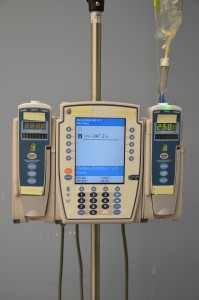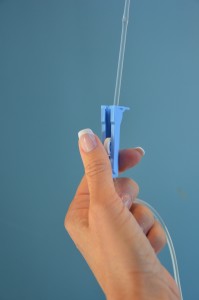Chapter 8. Intravenous Therapy
8.6 Infusing IV Fluids by Gravity or an Electronic Infusion Device (Pump)
To ensure therapeutic effectiveness of IV fluids, a constant, even flow is necessary to prevent complications from too much or too little fluid. A prescriber must order a rate of infusion for IV fluids. The rate of infusion for medications (given via a secondary or primary infusion) can be found in the Parenteral Drug Therapy Manual (PDTM). If an order for IV fluids is “to keep vein open” (TKVO), the minimum flow rate is 20 to 50 ml per hour, or according to physician’s orders (Fraser Health Authority, 2014).
A healthcare provider is responsible for regulating and monitoring the amount of IV fluids being infused. IV fluid rates are regulated in one of two ways:
- Gravity: The healthcare provider regulates the infusion rate by using a clamp on the IV tubing, which can either speed up or slow down the flow of IV fluids. An IV flow rate for gravity is calculated in gtts/min.
- Electronic infusion device (EID) (see Figure 8.20): The infusion rate is regulated by an electronic pump to deliver the fluids at the correct rate and volume. All IV pumps regulate the rate of fluids in ml/hr. An IV pump (EID) is used for many types of patients, solutions, and medications (Vancouver Coastal Health, 2008). These devices include a variety of safety features including alerts for air and occlusions, a medication administration library, the ability to calculate infused volumes, and back up battery power.
An EID / IV pump must be used:
- Whenever possible to avoid some complications associated with IV therapy
- With all opioid infusions (use a patient-controlled analgesia)
- For all pediatric patients
- As directed in the PDTM

Figure 8.20 Electronic infusion device (EID)
To calculate the drops per minute for an infusion by gravity, follow the steps in Table 8.9. Remember that you only have to do this when you are running the IV by gravity.
When an infusion is by gravity, there are several factors that may alter the flow/infusion rate (Fulcher & Frazier, 2007). In addition to regulating the flow rate, assess the IV system to ensure these factors are not increasing or decreasing the flow of the IV solution. These factors are listed in Table 8.10.
Table 8.10 Factors Influencing the Flow Rate of Infusions |
|||
Factors |
Additional Information |
||
| Tube occlusion | May occur if the tubing is kinked or bent. Tubing may become kinked if caught under the patient or on equipment, such as beds and bed rails. Sometimes the cannula itself is kinked at the insertion site. | ||
| Vein spasms | Irritating or chilled fluids (fluids stored in the fridge) may cause a reflex action that causes the vein to go into spasm at or near the intravenous infusion site. If fluids or medications are chilled, bring to room temperature prior to infusion. | ||
| Height of the fluid container | The IV tubing drip chamber should be approximately 3 feet above IV insertion site. | ||
| Location/position of IV cannula | If the cannula is located in an area of flexion (bend of an arm), the IV flow may be interrupted when the patient moves around. To avoid this issue, replace IV cannula. | ||
| Infiltration or extravasation | If the cannula punctures the vein, the fluid will leak into the surrounding tissue and slow or stop the flow, and swelling will develop. | ||
| Accidental touching/bumping of the control clamp or raising arm above heart level | Instruct the patient not to touch the roller clamp and to take care not to bump the clamp, as this may accidentally change the flow rate. Instruct patient to keep hand/arm below heart level; an elevated hand/arm will slow or stop an infusion running by gravity. | ||
| Needle or cannula gauge/diameter | The smaller the needle or cannula, the slower the fluid will flow. | ||
| Data sources: Fulcher & Frazier, 2007; Perry et al., 2018 | |||
Critical Thinking Exercises
- A patient with an IV running via gravity leaves the unit frequently. Midway through your shift you notice the IV is approximately 6 hours behind. Explain possible reasons. Explain your next steps.
Attribution
Figure 8.20. Electronic Infusion Device from BCIT is used under a CC BY-SA 4.0 international license.


